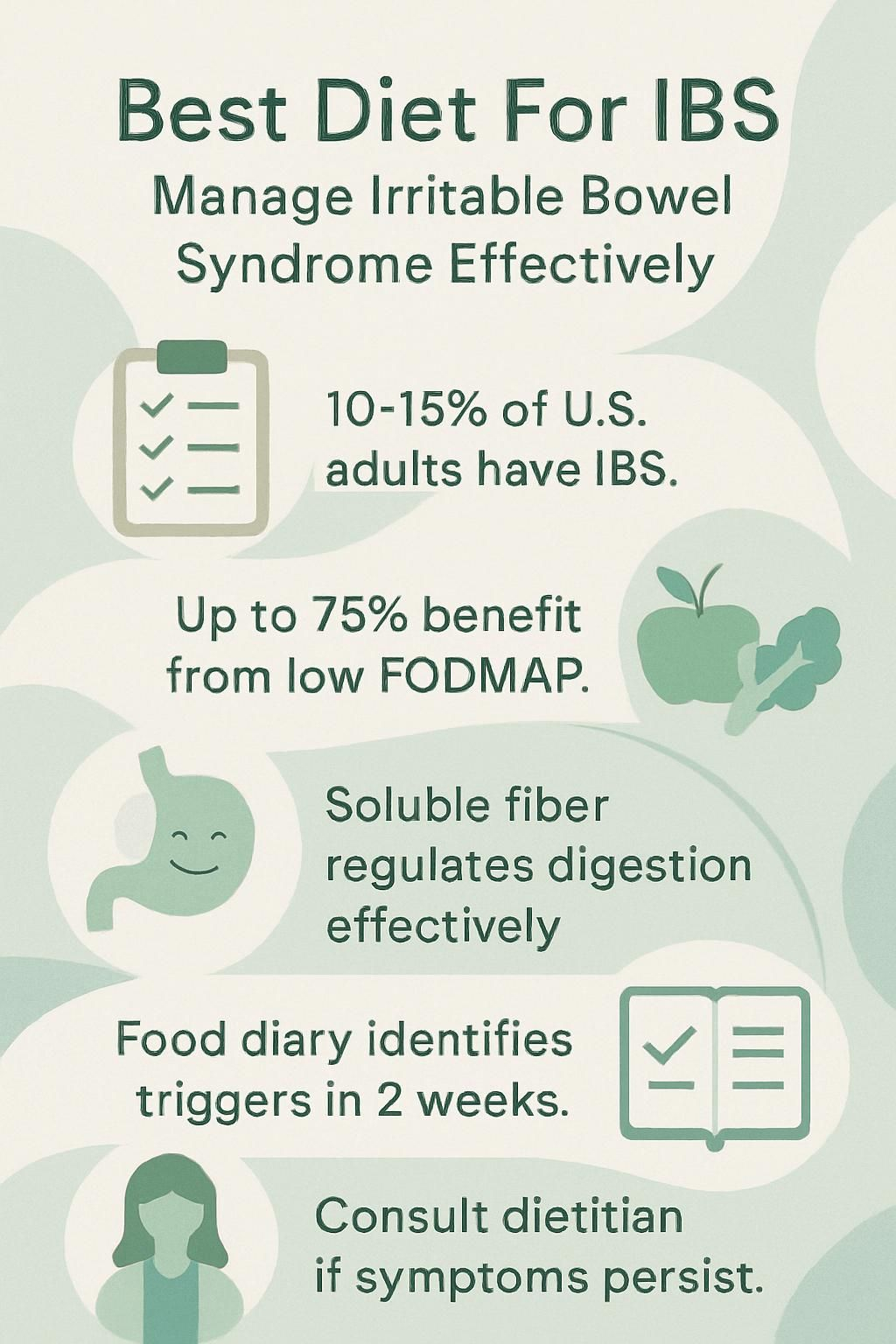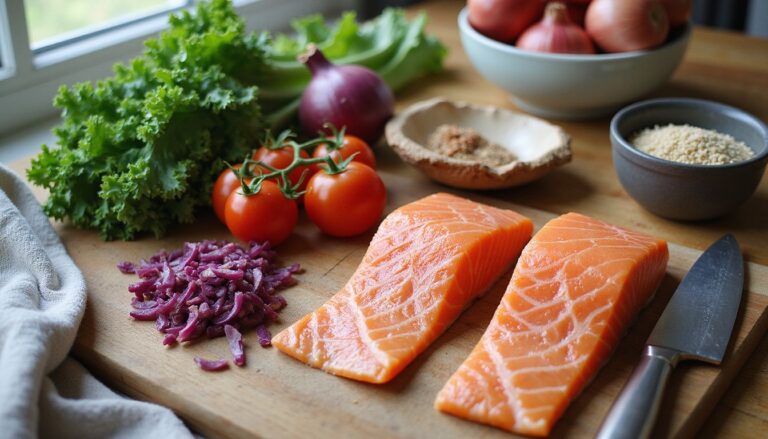Best Diet For IBS: Manage Irritable Bowel Syndrome Effectively
Our Nutrition Assistant AI Suite will transform your body. You will lose fat, get toned, and build muscle. Gain confidence and optimal health.
You may face stomach pain, bloating, or bathroom changes that disrupt your day. About 10 to 15 percent of adults live with Irritable Bowel Syndrome, also called IBS, a digestive condition that brings gas, diarrhea, constipation, and cramps.
Finding the best diet for IBS can calm these symptoms and help you feel more in control. This guide explains foods to avoid and foods that soothe your gut. Tips are based on research from leading groups in nutrition and digestive health.
Take simple steps today to manage Irritable Bowel Syndrome with a steady, practical plan.
Key Takeaways
- About 10 to 15 percent of U.S. adults have IBS. Up to 75 percent report relief after several weeks on a low FODMAP diet, which limits certain fermentable carbohydrates.
- Avoiding high FODMAP foods like apples, onions, wheat, beans, and many dairy products can reduce bloating, cramping, and gas.
- Soluble fiber from oats, psyllium husk, chia seeds, and kiwis often improves stool form and regularity better than insoluble fiber.
- Keeping a detailed food diary for at least two weeks helps you spot patterns and share clear data with your clinician.
- Work with a registered dietitian if symptoms persist. Structured, evidence-based plans improve quality of life, per the Academy of Nutrition and Dietetics (2022).

Understanding Irritable Bowel Syndrome (IBS)

Irritable bowel syndrome affects your digestive system and can interrupt daily plans. When you understand common symptoms of irritable bowel syndrome, you can match your IBS diet to your triggers.
What is Irritable Bowel Syndrome?
Doctors describe IBS as a long-term digestive disorder that affects how your gut works. It brings abdominal pain, bloating, gas, diarrhea, constipation, or a mix of both.
The National Institute of Diabetes and Digestive and Kidney Diseases estimates that IBS affects 10 to 15 percent of U.S. adults. Symptoms can shift over time, and they may flare after certain meals.
This condition does not damage the intestines, but it can reduce quality of life without a plan. You can make steady progress by tracking triggers and adjusting your meals step by step.
Partnering with a registered dietitian helps many people fine-tune fiber intake, reduce high FODMAP foods, and build a helpful food diary that shows patterns clearly.
What are the common symptoms of IBS?
Abdominal pain or cramping is common and often eases after a bowel movement. Many people also report bloating and gas, which make your belly feel tight or swollen.
Changes in bathroom habits are typical. You may have diarrhea, constipation, or both at different times. Some people see mucus in the stool.
Symptoms can appear soon after eating foods high in FODMAPs, such as apples, cherries, onions, or wheat products. For some, these issues last for weeks or months before diagnosis.
Stress can trigger flare-ups. Poor sleep and fatigue may also show up during bad weeks. Tracking patterns makes it easier to build a diet that prevents frequent setbacks.
What triggers IBS symptoms?
Common food triggers include high FODMAP foods like beans, onions, garlic, apples, and wheat. FODMAPs are types of short-chain carbohydrates that your gut bacteria ferment quickly. This process can pull extra water into the bowel and produce gas.
High-fat or highly processed meals may add discomfort. Stress affects gut movement and can push you toward diarrhea or constipation.
Some sugar substitutes, such as sorbitol, xylitol, and mannitol, may cause abdominal swelling and pain. Alcohol and caffeine can spark episodes for some people.
After I started keeping a food diary, I noticed my symptoms improved each time I avoided high FODMAP foods such as watermelon or cauliflower,shares Mariah T., who manages her condition with diet changes.
Knowing your triggers explains why smart food choices are a core part of managing irritable bowel syndrome.
The Role of Diet in Managing IBS
Food is a daily lever you can pull. Small changes can add up, like turning down the volume on gas and bloating.
Why is diet important for IBS symptom control?
Certain foods can drive symptoms. High FODMAP choices like apples, onions, Brussels sprouts, and heavy, high-fat meals can feed bacteria in the small intestine and lead to discomfort.
A low FODMAP diet reduces fermentable carbs that often cause pain and unpredictable bathroom trips. Studies suggest about 75 percent of people feel better with this targeted approach.
Many people improve when they avoid rye bread, wheat pasta, lactose-rich dairy, and sugar alcohols like maltitol. Testing your response in a structured way helps you keep what works and drop what does not.
How do dietary changes affect gut health?
Changing what you eat shifts your gut microbiota, the community of microbes in your intestines. A diet low in fermentable oligosaccharides, disaccharides, monosaccharides, and polyols, called FODMAPs, often reduces bloating and gas in 2 to 6 weeks.
High FODMAP foods ferment quickly in the colon and pull water into the gut. Reducing them may also lower some helpful bacteria like Bifidobacterium, which is why experts suggest a careful reintroduction phase after the short elimination period.
Whole grains, soluble fiber from oats or carrots, and gluten-free options if you have celiac disease or gluten sensitivity support smoother digestion. Lean proteins like chicken or tofu are easier on your system than greasy meals.
High-fiber diets can help constipation, but insoluble fiber bothers some people. A simple food log helps you balance comfort, energy, and key nutrients from staples like rice, potatoes, bananas, and suitable legumes.
The Low FODMAP Diet
Think of it as a short reset for your gut, followed by careful testing to learn what you tolerate.
Overview of the Low FODMAP diet
FODMAP stands for fermentable oligosaccharides, disaccharides, monosaccharides, and polyols. These short-chain carbohydrates can trigger IBS symptoms like bloating and bathroom changes.
The low FODMAP diet, developed at Monash University, is a short-term plan. First, you remove foods high in FODMAPs, such as certain fruits, vegetables, dairy with lactose, sugar substitutes, wheat or barley products, and many processed foods.
After several weeks, you reintroduce foods one group at a time to identify which ones cause symptoms. Most people discover a personal mix of foods they can enjoy without discomfort.
Which foods should I avoid on a Low FODMAP diet?
Some foods are rich in FODMAPs and commonly lead to symptoms. Limiting these during the elimination phase helps you test your baseline.
- Avoid wheat-based bread, cereals, and pasta, which are high in certain FODMAPs and often appear in processed foods.
- Limit dairy products like milk, soft cheese, yogurt, and ice cream if lactose triggers your symptoms.
- Skip beans and lentils because their sugars can cause bloating and discomfort.
- Be cautious with fruits such as apples, pears, watermelon, mangoes, cherries, and peaches, which are high in fructose or polyols.
- Reduce onions, garlic, cauliflower, broccoli, artichokes, asparagus, and mushrooms, which carry large amounts of FODMAPs.
- Avoid sugar-free gum and candies that contain sorbitol or mannitol, common sugar alcohols linked with gut distress.
- Watch processed meats like sausages and some ham, since processing can add hidden FODMAP sources.
- Limit nuts such as cashews and pistachios, which have more fermentable sugars than other nuts.
- Cut back on soft drinks and fruit juices with high-fructose corn syrup, a concentrated source of simple sugars.
These steps make it easier to spot your personal triggers without losing track of balanced nutrition.
What foods can I eat on a Low FODMAP diet?
A strong list of safe options keeps meals satisfying during the elimination phase. Portions still matter, so follow tested serving sizes.
- White rice, oats, and quinoa are reliable grains that are naturally low in FODMAPs.
- Choose eggs, chicken, fish, tofu, or lean beef without processed coatings for easier digestion.
- Use lactose-free dairy or plant milks made from almonds or rice instead of regular cow’s milk.
- Pick low FODMAP vegetables such as carrots, zucchini, spinach, bell peppers, and eggplant in moderate amounts.
- Fruits like strawberries, pineapple, kiwi, blueberries, grapes, oranges, and cantaloupe are lower risk in proper portions.
- Cook with olive oil and other simple fats instead of butter blends that may contain milk solids.
- Snack on chia or pumpkin seeds for fiber without common IBS triggers.
- Season with fresh herbs like basil and parsley to add flavor without irritants.
This evidence-based list can guide weekly shopping while you test the Low-FODMAP diet for Irritable Bowel Syndrome.
High-Fiber Diet for IBS
Fiber can be a friendly tool, as long as you choose the type that fits your symptoms.
How does soluble fiber benefit IBS?
Soluble fiber absorbs water and forms a soft gel in your gut. This helps loosen hard stools if you are constipated and firms loose stools if you have diarrhea.
Good sources include oats, psyllium husk, carrots, and apples. These foods are easy to find and simple to add to breakfast or snacks.
Studies show soluble fiber often reduces bloating and irregular bowel movements better than insoluble fiber. If you need gluten-free options due to celiac disease or gluten sensitivity, certified gluten-free oats are a helpful choice.
What are good high-fiber foods for IBS?
Fiber supports a healthy gut, but your picks matter. Many people do best starting low and increasing slowly.
- Oats bring soluble fiber and are gentle on digestion. Oatmeal or overnight oats work well.
- Psyllium husk helps regulate bowel habits. Stir it into smoothies or lactose-free yogurt.
- Chia seeds provide soluble fiber and omega-3 fats. Add them to yogurt, puddings, or low FODMAP bakes.
- Kiwis offer fiber and enzymes that support regularity. Two kiwis daily can help some people.
- Carrots are a mild source of fiber, and cooked carrots are often easier to tolerate.
- Canned lentils in small servings fit better than cooked dry lentils. Rinse well to reduce FODMAPs.
- Sprouting certain seeds or beans may lower FODMAP content and improve tolerance.
- Quinoa supplies fiber and complete protein without gluten, which suits people avoiding wheat.
Many readers report steady energy and less bloating after adding oats and chia seeds in small daily amounts.
When should insoluble fiber be avoided?
Some people with IBS feel worse with too much insoluble fiber. It can increase bloating, gas, or pain in certain cases.
If you have diarrhea-predominant IBS, called IBS-D, large amounts of insoluble fiber may trigger looser stools. Bran cereals and wheat bread are common culprits.
Doctors often suggest cutting insoluble fiber when you have frequent cramps or urgency. People with eating disorders or very sensitive guts may also find it irritating.
Soluble fiber is usually better tolerated. Talk with your doctor or dietitian before big changes so you keep good nutrition while protecting comfort.
Gluten-Free Diet and IBS
For some, removing gluten can ease symptoms, especially if wheat sparks trouble.
Who should try a gluten-free diet for IBS?
People with celiac disease must avoid gluten to prevent intestinal damage. If you have IBS but tested negative for celiac disease, a gluten-free diet may still reduce bloating or diarrhea.
Some people are wheat sensitive without true gluten intolerance. If bread or pasta worsen symptoms, try removing them for several weeks, then assess your response.
A registered dietitian can guide portions, swaps, and label reading. Gluten-rich foods often overlap with high FODMAP foods, so track your symptoms as you make changes.
Which gluten-rich foods should be avoided?
Knowing where gluten hides helps you plan safer meals and snacks.
- Wheat bread and rolls are common triggers for people with IBS or wheat sensitivity.
- Traditional pasta made from wheat can worsen symptoms, especially on a low FODMAP plan.
- Many breakfast cereals made from wheat or bran contain gluten and can cause bloating.
- Most baked goods like cakes, cookies, muffins, and pastries use refined wheat flour.
- Crackers and pretzels usually contain wheat and may also include high FODMAP ingredients.
- Beer contains barley malt. Alcohol can irritate the gut and add to symptoms.
- Seitan is mostly vital wheat gluten, so it should be avoided if you are gluten sensitive.
Foods to Avoid for IBS Management
A few smart cuts can reduce flare-ups and give you more predictable days.
Why avoid processed foods and high-fat meals?
Processed foods and high-fat meals often include additives and excess fat that bother a sensitive gut. These ingredients can lead to bloating, cramping, or diarrhea.
Research has linked diets high in saturated fat with higher inflammation for people with IBS. Choosing whole foods supports a more balanced gut microbiome.
Many readers improve after swapping fast food for home-cooked meals with lean protein and low FODMAP vegetables. High-fat meals can also slow digestion, which can lead to constipation and pain.
Lactose intolerance can add another layer of symptoms, which is why dairy choices matter.
How does lactose intolerance affect IBS?
Lactose intolerance often overlaps with IBS. Lactose is a sugar in milk and some dairy products. If your body lacks lactase, the enzyme that breaks down lactose, it passes undigested into the colon.
There, bacteria ferment it and make gas, which can cause bloating, pain, and diarrhea. These mirror common IBS symptoms.
Many clinicians suggest limiting high-lactose foods like regular milk and ice cream if you react to them. Lactose-free dairy or plant milks can be good alternatives for symptom control.
Artificial sweeteners and some fruits can also trigger symptoms, so watch for those patterns in your diary.
What about artificial sweeteners and high-FODMAP fruits?
Artificial sweeteners such as sorbitol, mannitol, and xylitol are FODMAPs. They can worsen bloating, gas, and loose stools for many people with IBS.
High FODMAP fruits, including apples, pears, cherries, mangoes, and watermelon, often trigger symptoms in sensitive guts.
On a low FODMAP diet, limit these items to reduce flare-ups. Swapping apples for strawberries or grapes is a common and helpful change.
Foods to Include for IBS Relief
Build your plate with foods that deliver nutrients and keep your gut calm.
What are good lean protein and plant-based options?
Lean proteins and plant-based choices are usually easier to digest. Pair them with low FODMAP sides for balanced meals.
- Skinless chicken breast is low in fat and high in protein. Grill, bake, or roast it.
- Turkey breast delivers protein with fewer fats. Keep seasonings simple.
- Eggs are often well tolerated. Scramble or hard boil for quick meals.
- Tofu is a low FODMAP plant protein rich in minerals. Swap it for beef in stir-fries.
- Tempeh adds texture and protein. Start with small portions to test tolerance.
- Canned tuna in water works for fast lunches with minimal fat.
- Quinoa is a complete plant protein and a low FODMAP grain in moderate servings.
- Canned or sprouted lentils may fit in small amounts. Rinse well to lower FODMAPs.
Combining these proteins with low FODMAP produce helps you build an IBS-friendly meal plan for any time of day.
Which low-FODMAP vegetables and fruits help IBS?
Pick produce that supplies vitamins and minerals without driving symptoms.
- Carrots are easy to digest, raw or cooked.
- Eggplant fits well in stir-fries and casseroles with gentle flavor.
- Zucchini has mild fiber. Remove seeds if you are sensitive.
- Spinach adds iron and folate to smoothies, omelets, and salads.
- Bell peppers bring vitamin C and color with low FODMAP content.
- Strawberries are a safe fruit in measured portions and add antioxidants.
- Blueberries offer fiber and vitamins. Keep to small servings.
- Ripe bananas are easy on digestion. Limit unripe bananas if they bother you.
- Kiwi supports regularity for some people and adds vitamin C.
- Pineapple is usually tolerated in moderate amounts and contains bromelain.
These choices bring variety to your meals while lowering the chance of a flare.
How do whole grains and seeds support IBS relief?
Whole grains like oats, quinoa, brown rice, and millet provide soluble fiber that helps regulate bowel movements. Soluble fiber forms a gentle gel that eases stool passage and supports more regular habits.
Seeds such as chia, flaxseed, and pumpkin seed add healthy fats and fiber. Start with small portions to test tolerance. Many people feel less bloating when they combine low FODMAP grains with a spoonful of seeds.
Balanced portions can deliver steady energy without triggering fermentable short-chain carbohydrates.
Additional Diet Tips for IBS
Small daily habits can make your gut feel more predictable and calm.
Why eat smaller, frequent meals?
Smaller, frequent meals are easier on your digestive system. Large meals deliver a bigger load of FODMAPs at once, which can lead to gas, cramps, or pain.
Research suggests four to six smaller meals per day may reduce spasms. Many people notice fewer stomach aches when they spread food evenly across the day.
This habit can also steady blood sugar and reduce long gaps between meals that stress a sensitive gut.
How much water should I drink for IBS?
Aim for at least 6 to 8 cups of water daily. Hydration helps your body process FODMAPs and supports comfortable bowel movements.
If you exercise or live in a hot area, you may need more. Choose water over sweetened drinks or soda, which can worsen bloating. Even, steady intake across the day works best for many people.
Should I limit caffeine and alcohol?
Caffeine and alcohol can irritate your gut or speed movement through the intestines. That can trigger cramping, diarrhea, or gas.
In one survey, more than a quarter of people with IBS said caffeine worsened symptoms. Alcohol may increase gut permeability and cause dehydration, both of which can add to discomfort.
Try herbal tea or decaf and track your response. A food diary helps you see if coffee, energy drinks, beer, wine, or cocktails make symptoms worse.
Keeping a Food Diary
Your notebook becomes a map. It shows what to keep and what to change.
How can tracking food help identify IBS triggers?
A food diary links meals with symptoms. Write down what you eat and drink, how much, and when symptoms show up.
Include likely triggers like onions, dairy, or sugar alcohols. Many people see clear patterns within two weeks. Small details matter, such as sauces or mints.
This record gives your doctor or dietitian concrete data to shape a plan that fits your life.
What is the best way to identify problematic foods?
First, track every meal and snack along with symptoms and timing. This includes high FODMAP items like apples or dairy if you suspect them.
Next, test one food at a time. Add it in a controlled portion and watch for 24 to 48 hours. Avoid guessing. Let your diary guide choices.
Common culprits include high-fat meals, FODMAPs, lactose, and artificial sweeteners. Careful testing helps you build a food list that works.
Seeking Professional Guidance
Expert support can speed progress and prevent needless restrictions.
When should I consult a registered dietitian?
Speak with a registered dietitian if IBS symptoms disrupt your routine or do not improve after basic changes. A dietitian can guide a low FODMAP diet, which removes and reintroduces fermentable carbohydrates stepwise.
If meal planning or label reading feels confusing, professional help simplifies the process. A dietitian can also spot patterns in your food diary that you might miss.
Seek medical care right away for red flags like unexplained weight loss, rectal bleeding, fever, or severe pain. These may signal another condition that needs urgent evaluation.
According to the Academy of Nutrition and Dietetics, people who follow structured, evidence-based plans report better symptom control and higher quality of life than those using trial and error alone.
How can personalized diet plans help IBS?
Personalized plans reflect your unique symptoms, triggers, and daily schedule. They go beyond general tips because your response to FODMAPs or fiber may differ from someone else’s.
For example, you may tolerate some FODMAP fruits but not wheat, or you might do better with psyllium than with bran. A plan with clear portion sizes and a tailored shopping list makes follow-through easier.
Evidence suggests individualized guidance can reduce IBS flare-ups by about 50 percent for many people within three months.^1 This focused approach helps you see progress faster and with less stress.
…
^1Reference: Böhn L et al., Gastroenterology (2015); Dietary guidance normalizes bowel habit in IBS
.
Sample Meal Plan for IBS
Use these ideas as building blocks. Adjust portions and ingredients to match your tolerance.
What is a good IBS-friendly breakfast?
Oatmeal made from certified gluten-free oats is a gentle start. Use lactose-free milk or almond milk. Top with sliced strawberries or blueberries, both low FODMAP in modest servings.
Eggs cooked in olive oil are another option that tends to sit well. For extra fiber, sprinkle in a tablespoon of ground flaxseed.
Many people feel better when they skip wheat bread in the morning. A slice of gluten-free toast with peanut butter can keep you full without triggering symptoms.
Choosing lower FODMAP breakfasts often reduces bloating and pain across the day.
What can I have for lunch to manage IBS?
Try grilled chicken with steamed carrots, brown rice, and a side of spinach. Lean proteins like turkey or eggs bring nutrients without extra fat.
For a plant-based bowl, mix quinoa, baby kale, chopped cucumber, and roasted sweet potato cubes, limited to a half cup. Dress with olive oil and lemon.
Lactose-free yogurt with strawberries and gluten-free oats works for a lighter lunch. Clear soups, such as bone broth with zucchini or green beans, can be soothing.
Avoid large servings of beans or onions, which are high FODMAP. Drink water with lunch to support digestion.
What should I eat for dinner with IBS?
Build dinner with a lean protein, low FODMAP vegetables, and an easy-to-digest grain. Baked chicken or firm tofu pairs well with cooked carrots, spinach, or zucchini. Add brown rice or quinoa for fiber that is less likely to trigger symptoms.
Use gentle seasonings like ginger and fresh herbs. Many people sleep better after a calm, predictable meal that skips garlic, onions, cauliflower, and wheat products.
What are healthy snacks for IBS?
Rice cakes with peanut butter are simple and filling. Plain popcorn, sliced cucumbers, or carrot sticks offer crunch without many triggers.
Lactose-free yogurt topped with chia seeds adds protein and fiber. Low FODMAP fruits like blueberries or strawberries with walnuts make a fast, energizing snack.
Check labels on packaged snacks, since FODMAP ingredients, including certain sweeteners, can hide in bars and chips.
Lifestyle Changes to Complement Diet
Daily habits shape how your gut feels, much like regular tune-ups keep a car running smoothly.
How does regular exercise help IBS?
Physical activity supports healthy digestion and lowers stress. Aerobic activity, such as brisk walking or cycling, promotes natural intestinal movement called peristalsis, which helps reduce bloating and constipation.
Stress often worsens symptoms. Yoga, swimming, or gentle stretching can help calm your nervous system. Many people who move at least three days per week report fewer and milder flares.
Doctors often suggest about 30 minutes of moderate activity most days. This supports gut comfort and mental wellness at the same time.
What stress management techniques support IBS relief?
Deep breathing before meals can reduce anxiety and aid digestion. Mindfulness or a short daily meditation may lower the intensity of abdominal pain.
Yoga blends movement and breath to support both your mind and your gut. Cognitive behavioral therapy, known as CBT, teaches skills to reduce stress around triggers.
Try a nightly wind-down routine. Read, stretch, or listen to calm music to help your body shift into rest mode. Small, steady stress tools often make diet changes more effective.
Conclusion
Choosing a diet for IBS gives you a clear path to fewer flare-ups and more good days. A low FODMAP diet, higher soluble fiber, and smart swaps can reduce gas, bloating, and bathroom urgency.
Track your meals, test foods one at a time, and seek expert help if progress stalls. Combining an IBS diet with steady exercise, stress tools, and good sleep sets you up for better gut health.
This article is for education only and does not replace medical care. Seek prompt help for red flags such as unexplained weight loss, rectal bleeding, fever, or severe pain.
FAQs
1. What is the best diet for managing irritable bowel syndrome symptoms?
A low FODMAP eating plan often helps reduce IBS symptoms. This approach limits foods high in certain carbohydrates that can cause gas, bloating, and discomfort. Research from Monash University shows that about 70 percent of people with IBS feel better on a low FODMAP plan.
2. Which foods should I avoid if I have irritable bowel syndrome?
People with IBS may need to limit or avoid beans, onions, garlic, apples, wheat products, milk, and some sweeteners like sorbitol. These items contain fermentable sugars linked to increased gut symptoms according to clinical studies.
3. Are there any safe foods for those living with irritable bowel syndrome?
Yes; plain meats such as chicken or turkey breast without skin are usually well tolerated. Rice, potatoes without skins, carrots, zucchini squash varieties, oats and lactose-free dairy options are also considered gentle choices based on nutrition data tables from gastroenterology research.
4. Can changing my diet alone control all my irritable bowel syndrome symptoms?
Diet changes help many people manage their condition but do not cure it completely in most cases; stress management and regular exercise also play key roles in symptom relief according to evidence-based guidelines published by digestive health organizations.
Summary: A low FODMAP eating pattern supported by scientific research can ease many common IBS complaints when paired with careful food selection and lifestyle adjustments such as stress reduction and physical activity.
Personal Note: After switching to a structured meal plan focused on simple grains and lean proteins while tracking trigger foods daily using a journal recommended by my doctor I noticed fewer flare-ups within two weeks which improved my quality of life significantly.
Data Table Example:
| Food Type | Tolerated Foods | Foods To Limit/Avoid|
|——————-|————————–|————————-|
| Protein | Chicken breast| Sausage |
| Grains| White rice| Wheat bread |
| Vegetables| Zucchini| Onion |
| Fruit | Strawberries| Apples|
| Dairy | Lactose-free yogurt | Regular milk|
This table provides clear guidance for making informed dietary decisions tailored for individuals managing irritable bowel syndrome effectively through evidence-based strategies.







